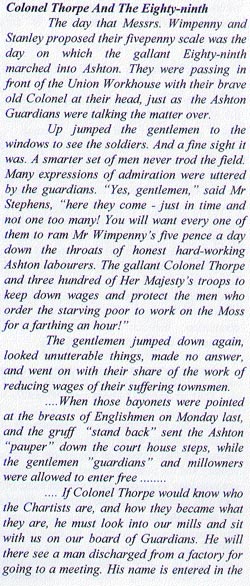| HOME | | STANLEY | | OLIVER | | CULLEN | | PIETTE | | CONTACT | |
The Poor Law Amendment Act was introduced in 1834. This replaced any pre-existing laws with a national system for dealing with poverty, and its relief, based around the Union Workhouse. Ashton Parish had already erected a workhouse on Dungeon Street (now Market Street) in 1730 and initially, after Ashton Poor Law Union was formed on 3rd February 1837, the elected Board of Guardians made use of this facility, extending it somewhat to increase its capacity.

Right from the beginning the population of the Poor Law union (72,516 according to 1831 Census figures)resisted the new laws and workhouse admission for paupers, preferring the old system of outdoor parish relief. The workhouse system had been devised to make the regime as unattractive as possible and, therefore, not likely appeal to anyone able to make any sort of living for themselves.
The Reverend Joseph Rayner Stephens, our leading Chartist in the Tameside area, produced and edited a newspaper "The Ashton Chronicle", bound copies of which are available at Stalybridge Local Studies Library. Whilst browsing through this book I began to notice a repeating theme of articles severely critical of the Poor Law Guardians and of one Mr John Strongitharm Stanley in particular.
Mr Stanley had been elected to serve on April 13th 1848, also elected that day was Joseph Rayner Stephens. The names of the other guardians were comprised mostly of millowners and other businessmen of the district quite a number of the names I had come across before.
In all likelihood the other guardians were also equally interconnected. Quite a cosy little group!
On 27th April 1848 a committee was formed to devise the best method of finding employment for the able-bodied applicants for relief and the best way to design an "all work" test i.e. people had to work for their poor relief unless classified as sick (What changes?). The members of this sub-committee were Thomas Mellor, Joseph Rayner Stephens, William Peacock, Edward Whitehead, John S Stanley and John Ousey (Master of the Workhouse). By the 24th June 1848 John Stanley had acquired the lease of seven and a half acres of land on Ashton Moss from the Earl of Stamford to create a farm for the purpose of setting people to work.
Roundabout the same time Robert Wood (Surgeon) had assessed the current facilities of the Workhouse and declared that it could accommodate no more than 170 persons. John Stanley and Thomas Mellor visited Swinton School (a boarding school for orphans and pauper children), and had been pleased with what they saw and resolved to recommend to committee that Ashton children be sent there. Running throughout the Guardian's Minutes over a two year period was the desparate need to build a new workhouse. Facilities were obviously stretched to the extreme, so only the oldest and frailest could be admitted.
The sub-committee continue to meet to work on their strategies for the farm, but no minutes were produced for public scrutiny. Just as the poor of the district began to think there could be a solution to their ills the Chairman of the Board of Guardians, Mr Whimpenny, announced the rate of pay for working on the farm:
Joseph Rayner Stephens was incensed and could not have been more scathing in his condemnation at this announcement in articles in the "Ashton Chronicle". Some guardians wanted nothing to do with this plan, others feared for their safety when the local poor heard of this plan.
There had been an alternative suggestion of 1 shilling a day, but as one millowner (Mr Stanley?) expounded "How could he fill his mill with workers if they could earn a shilling a day on the farm?" What an own goal!
Here is a summary of an article written by Joseph Rayner Stephens a few weeks later. This was rather a long article and fortunately summarised by Robert E. Reece in his book "People of Stalybridge" published in the year 2000.

|  |
A year later an inspection of Swinton School took place where conditions were not as previously thought. In fact, they had deteriorated so badly that the repeated illnesses of the children raised concerns. It was agreed at a Board meeting that Ashton children be removed and returned to Ashton as soon as possible. The Guardians had also not been able to carry out their "able-bodied" test, with 180 able bodied men and 400 women the, by then, ten acres of land on the farm could not support work for all.
At a meeting towards the end of 1849 it was finally resolved to build a new workhouse to accommodate 500 inmates.

SOURCES:
| HOME | | STANLEY | | OLIVER | | CULLEN | | PIETTE | | CONTACT | |
Gay J Oliver © 2002 - all rights reserved